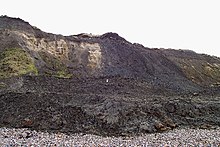London Clay
| London Clay Formation Stratigraphic range: Ypresian |
|
|---|---|

London Clay at Reculver
|
|
| Type | Formation |
| Unit of | Thames Group |
| Underlies | Bagshot Formation (London Basin), Wittering Formation and Poole Formation (Hampshire Basin and English Channel) |
| Overlies | Harwich Formation |
| Thickness | up to 150 m |
| Location | |
| Region | southern England |
 Geological map of the London Basin; the London Clay is marked in dark brown. |
|
The London Clay Formation is a marine geological formation of Ypresian (Lower Eocene Epoch, c. 56–49 Ma) age which crops out in the southeast of England. The London Clay is well known for its fossil content. The fossils from the Lower Eocene indicate a moderately warm climate, the tropical or subtropical flora. Though sea levels changed during the deposition of the Clay, the habitat was generally a lush forest – perhaps like in Indonesia or East Africa today – bordering a warm, shallow ocean.
The London Clay is a stiff bluish clay which becomes brown when weathered. Nodular lumps of pyrite and crystals of selenite (sometimes called "waterstones") frequently exist in the clay, and large septarian concretions are also common. These have been used in the past for making cement. They were once dug for this purpose at Sheppey, near Sittingbourne, and at Harwich, and also dredged, off the Hampshire coast. The clay is still used commercially for making bricks, tiles, and coarse pottery in places such as Michelmersh in Hampshire. It is infertile for gardens and crops.
The London Clay is well developed in the London Basin, where it thins westwards from around 150 metres (492 feet) in Essex and north Kent to around 4.6 metres (15 feet) in Wiltshire. though it is not frequently exposed as it is to a great extent covered by more recent Neogene sediments and gravel deposits. One location of particular interest is Oxshott Heath, where the overlying sand and the London Clay layers are exposed as a sand escarpment, rising approximately 25 metres (82 feet). This supported a thriving brick industry in the area until the 1960s. The London Clay is also well developed in the Hampshire Basin, where an exposure 91 metres (299 ft) thick occurs at Whitecliff Bay on the Isle of Wight and around 101 metres (331 ft) is spread along 6 kilometres (4 miles) of foreshore at Bognor Regis, West Sussex.
...
Wikipedia
